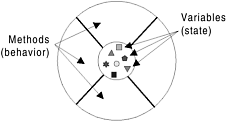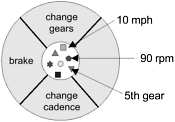What Is an Object?
Objects are key to understanding object-oriented technology. You can look around you now and see many examples of real-world objects: your dog, your desk, your television set, your bicycle.
These real-world objects share two characteristics: They all have state and behavior. For example, dogs have state (name, color, breed, hungry) and behavior (barking, fetching, and wagging tail). Bicycles have state (current gear, current pedal cadence, two wheels, number of gears) and behavior (braking, accelerating, slowing down, changing gears).
Software objects are modeled after real-world objects in that they too have state and behavior. A software object maintains its state in one or more variables. A variable is an item of data named by an identifier. A software object implements its behavior with methods. A method is a function (subroutine) associated with an object.
Definition
An object is a software bundle of variables and related methods.
You can represent real-world objects by using software objects. You might want to represent real-world dogs as software objects in an animation program or a real-world bicycle as a software object in the program that controls an electronic exercise bike. You can also use software objects to model abstract concepts. For example, an event is a common object used in Graphical User Interface (GUI) window systems to represent the action of a user pressing a mouse button or a key on the keyboard. Figure 28 is a common visual representation of a software object.
Figure 28. A software object.

Everything that the software object knows (state) and can do (behavior) is expressed by the variables and the methods within that object. A software object that modeled your real-world bicycle would have variables that indicated the bicycle's current state: Its speed is 10 mph, its pedal cadence is 90 rpm, and its current gear is the 5th gear. These variables are formally known as instance variables because they contain the state for a particular bicycle object, and in object-oriented terminology, a particular object is called an instance. Figure 29 illustrates a bicycle modeled as a software object.
Figure 29. A bicycle modeled as a software object.

In addition to its variables, the software bicycle would also have methods to brake, change the pedal cadence, and change gears. (The bike would not have a method for changing the speed of the bicycle, as the bike's speed is just a side effect of what gear it's in, how fast the rider is pedaling, whether the brakes are on, and how steep the hill is.) These methods are formally known as instance methods because they inspect or change the state of a particular bicycle instance. [1]
[1] Only the state and the behavior related to the object are included in the object. For example, your bicycle (probably) doesn't have a name, and it can't run, bark, or fetch. Thus, there are no variables or methods for those states and behaviors in the bicycle class.
The object diagrams show that the object's variables make up the center, or nucleus, of the object. Methods surround and hide the object's nucleus from other objects in the program. Packaging an object's variables within the protective custody of its methods is called encapsulation. This conceptual picture of an objecta nucleus of variables packaged within a protective membrane of methodsis an ideal representation of an object and is the ideal that designers of object-oriented systems strive for. However, it's not the whole story. Often, for practical reasons, an object may wish to expose some of its variables or to hide some of its methods. In the Java™ programming language, an object can specify one of four access levels for each of its variables and methods. The access level determines which other objects and classes can access that variable or method. Refer to the section Controlling Access to Members of a Class (page 193) for details.
Encapsulating related variables and methods into a neat software bundle is a simple yet powerful idea that provides two primary benefits to software developers.
- Modularity: The source code for an object can be written and maintained independently of the source code for other objects. Also, an object can be easily passed around in the system. You can give your bicycle to someone else, and it will still work.
- Information hiding: An object has a public interface that other objects can use to communicate with it. The object can maintain private information and methods that can be changed at any time without affecting the other objects that depend on it. You don't need to understand the gear mechanism on your bike to use it.
Getting Started
- About the Java Technology
- How Will Java Technology Change My Life?
- First Steps (Win32)
- First Steps (UNIX/Linux)
- First Steps (MacOS)
- A Closer Look at HelloWorld
- Questions and Exercises
- Code Samples
Object-Oriented Programming Concepts
- What Is an Object?
- What Is a Message?
- What Is a Class?
- What Is Inheritance?
- What Is an Interface?
- How Do These Concepts Translate into Code?
- Summary
- Questions and Exercises
- Code Samples
Language Basics
Object Basics and Simple Data Objects
Classes and Inheritance
Interfaces and Packages
Handling Errors Using Exceptions
- What Is an Exception?
- The Catch or Specify Requirement
- Catching and Handling Exceptions
- Specifying the Exceptions Thrown by a Method
- How to Throw Exceptions
- Runtime Exceptions The Controversy
- Advantages of Exceptions
- Summary of Exceptions
- Questions and Exercises
- Code Samples
Threads: Doing Two or More Tasks at Once
- What Is a Thread?
- Using the Timer and TimerTask Classes
- Customizing a Threads run Method
- The Life Cycle of a Thread
- Understanding Thread Priority
- Synchronizing Thread
- Grouping Threads
- Summary of Threads
- Questions and Exercises
- Code Samples
I/O: Reading and Writing
- Overview of I/O Streams
- Using the Streams
- Object Serialization
- Working with Random Access Files
- And the Rest…
- Summary of Reading and Writing
- Questions and Exercises
- Code Samples
User Interfaces That Swing
- Overview of the Swing API
- Your First Swing Program
- Example Two: SwingApplication
- Example Three: CelsiusConverter
- Example Four: LunarPhases
- Example Five: VoteDialog
- Layout Management
- Threads and Swing
- Visual Index to Swing Components
- Summary
- Questions and Exercises
- Code Samples
Appendix A. Common Problems and Their Solutions
- Appendix A. Common Problems and Their Solutions
- Getting Started Problems
- General Programming Problems
- Applet Problems
- User Interface Problems
Appendix B. Internet-Ready Applets
- Appendix B. Internet-Ready Applets
- Overview of Applets
- AWT Components
- Taking Advantage of the Applet API
- Practical Consideration of Writing Applets
- Finishing an Applet
- Swing-Based Applets
- Code Samples
Appendix C. Collections
- Appendix C. Collections
- Introduction
- Interfaces
- Implementations
- Algorithms
- Custom Implementations
- Interoperability
Appendix D. Deprecated Thread Methods
- Appendix D. Deprecated Thread Methods
- Why Is Thread.stop Deprecated?
- Why Are Thread.suspend and Thread.resume Deprecated?
- What about Thread.destroy?
- Why Is Runtime.runFinalizersOnExit Deprecated?
Appendix E. Reference
EAN: 2147483647
Pages: 125
